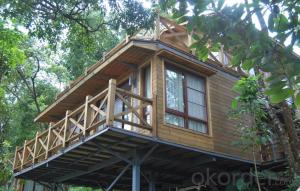Prefab wooden Houses
- Loading Port:
- China Main Port
- Payment Terms:
- TT OR LC
- Min Order Qty:
- -
- Supply Capability:
- -
OKorder Service Pledge
Quality Product, Order Online Tracking, Timely Delivery
OKorder Financial Service
Credit Rating, Credit Services, Credit Purchasing
You Might Also Like
Prefab wooden Houses
Simple and founctional family living house
Steel frame house
Fast Installation
Cost effective
Strong
Advantages of our LGS prefab house:
1,Quick/easy assembly (labor time/cost saving)
2,Economic/affordable.
3,Strong and durable.
4,Green and energy efficiency.
5,Pre-designed and over-engineered.
6,Customized--design flexibility.
7,Anti-seismic, anti-hurricane and anti-corrosion.
8,Termite resistance.
9,Transportation cost saving
10, Advanced manufacturing facilities/system.
- Q:Are container houses energy-efficient?
- Yes, container houses can be energy-efficient. They are designed to provide good insulation, reducing the need for heating and cooling. Additionally, container houses can incorporate energy-efficient systems such as solar panels, LED lighting, and energy-efficient appliances, further reducing energy consumption.
- Q:Can container houses be designed with sustainable materials?
- Yes, container houses can definitely be designed with sustainable materials. Container houses are constructed using shipping containers, which are made of durable materials like steel. However, in order to make them more sustainable, various modifications can be made. Firstly, sustainable insulation materials can be used to improve energy efficiency and reduce the need for excessive heating or cooling. This can include materials like recycled denim, cellulose insulation, or natural fiber insulation. These options not only provide effective insulation but also reduce the carbon footprint associated with the construction process. Secondly, sustainable flooring options can be used, such as bamboo or cork, which are renewable and have a lower impact on the environment compared to traditional flooring materials. Additionally, reclaimed or recycled wood can be used for interior finishes, reducing the demand for new timber. Furthermore, sustainable roofing materials like solar panels or green roofs can be incorporated into container house designs. Solar panels can generate renewable energy, reducing the reliance on non-renewable sources. Green roofs, on the other hand, can provide natural insulation, reduce stormwater runoff, and create a habitat for plants and wildlife. Lastly, the use of low VOC (volatile organic compounds) paints and adhesives can contribute to a healthier indoor environment by minimizing the release of harmful chemicals into the air. Overall, container houses can be designed with sustainable materials, making them more environmentally friendly and contributing to a more sustainable future.
- Q:Are container houses suitable for military or disaster relief purposes?
- Yes, container houses are suitable for military or disaster relief purposes. These houses, made from repurposed shipping containers, offer numerous advantages in such situations. Firstly, container houses are highly durable and can withstand extreme weather conditions and even earthquakes. This makes them ideal for disaster-prone areas where traditional buildings may be easily damaged. Additionally, container houses are portable and can be easily transported to remote or inaccessible locations, which is crucial for military operations or disaster relief efforts. They can be quickly set up and used as temporary shelters, field hospitals, or command centers. The standardized size and structure of shipping containers also make them easy to stack and arrange in various configurations, allowing for efficient use of space and resources. Furthermore, container houses are cost-effective compared to traditional construction methods. The use of repurposed shipping containers significantly reduces material costs, making them a more affordable housing solution for military or disaster relief organizations working with limited budgets. Moreover, container houses can be quickly assembled and disassembled, allowing for easy relocation or reuse in different areas, maximizing their long-term value. Finally, container houses can be customized to meet the specific needs and requirements of military or disaster relief operations. They can be equipped with insulation, ventilation systems, plumbing, and electrical installations, ensuring a comfortable and functional living space for personnel or displaced individuals. In conclusion, container houses are well-suited for military or disaster relief purposes due to their durability, portability, cost-effectiveness, and customization options. They offer a practical and efficient solution for providing temporary housing and infrastructure in challenging environments, supporting the efforts of military personnel and aid organizations in times of crisis.
- Q:Can container houses be designed as weekend getaway homes?
- Yes, container houses can definitely be designed as weekend getaway homes. In fact, they are becoming increasingly popular for this purpose. Container houses offer several advantages that make them ideal for weekend getaways. Firstly, container houses are highly customizable, allowing you to design and create a unique space that suits your specific needs and preferences. With the right design and layout, you can transform a container into a cozy and comfortable weekend retreat. Secondly, container houses are relatively affordable compared to traditional homes or vacation properties. Containers can be purchased at a lower cost and converted into livable spaces at a fraction of the price of a conventional house. This affordability makes them an attractive option for those looking for a budget-friendly getaway home. Additionally, container houses are portable and easy to transport. This means that you can easily relocate your weekend getaway home to different locations, allowing you to explore new areas and enjoy different experiences. It also gives you the flexibility to move your getaway home to a more suitable location based on the season or personal preferences. Furthermore, container houses are eco-friendly. By repurposing shipping containers, you are effectively recycling and reducing waste. Additionally, container homes can be equipped with energy-efficient features such as solar panels, rainwater harvesting systems, and energy-saving appliances, making them environmentally sustainable options for a weekend retreat. Lastly, container houses can be designed to provide all the necessary amenities for a comfortable getaway experience. From bedrooms and bathrooms to kitchens and living areas, containers can be transformed into fully functional living spaces. With proper insulation and ventilation, container houses can offer the same level of comfort as traditional homes. In conclusion, container houses can be excellently designed as weekend getaway homes. They offer customization options, affordability, portability, sustainability, and the ability to provide all necessary amenities. With the right design and planning, container houses can provide a unique and enjoyable weekend escape.
- Q:What is the average lifespan of a container house?
- The average lifespan of a container house is approximately 25 to 30 years.
- Q:Are container houses suitable for areas with limited access to schools?
- Container houses offer a viable solution in areas where schools are scarce or hard to reach. These houses are constructed using repurposed shipping containers, known for their durability and ease of transportation. Their compact size makes them ideal for areas with limited space, allowing for quick installation. In regions with limited access to schools, container houses can meet the needs of families, including school-aged children. They can be equipped with essential amenities such as electricity, water, and sanitation facilities, ensuring a comfortable living environment. Furthermore, container houses can be customized and expanded according to requirements, enabling the creation of dedicated spaces for educational purposes. These spaces can serve as temporary solutions, providing designated study areas or small classrooms within the house. This ensures that children have access to education despite the lack of nearby schools. Moreover, container houses can be easily relocated if necessary. This flexibility allows for easy adjustment when a school is established in the vicinity or when access to schools improves in the future. However, it is important to acknowledge that container houses alone cannot fully replace the advantages of a traditional school environment. Peer interaction, specialized teaching resources, and a comprehensive curriculum are essential components of education that may not be fully replicable within a container house. Therefore, while container houses provide a temporary solution, continuous efforts should be made to improve long-term access to schools. In conclusion, container houses can serve as a suitable option in areas with limited access to schools. They offer a temporary solution, ensuring children have access to education. However, it is crucial to continuously work towards improving educational infrastructure and opportunities for children in these areas.
- Q:Can container houses be built with a separate guest house or studio?
- Yes, container houses can be built with a separate guest house or studio. The versatility and modularity of container houses make it possible to create additional living spaces or structures within the same property. By stacking or joining multiple containers, architects and designers can easily construct separate guest houses or studios alongside the main container house. These additional structures can be customized to meet specific requirements and can serve various purposes, such as providing a comfortable space for guests, serving as a home office or studio, or even functioning as a rental property. The flexibility of container construction allows for a wide range of design possibilities, making it feasible to incorporate separate guest houses or studios into container house projects.
- Q:Can container houses be designed with multiple bedrooms?
- Container houses have the potential to feature multiple bedrooms. These houses offer high levels of customization, allowing for the accommodation of various floor plans and layouts. By carefully planning and incorporating creative design elements, it is possible to include multiple bedrooms in a container house. To achieve this, additional container units can be stacked or joined together, creating more living spaces and separate bedrooms. The layout can be adjusted to include multiple bedrooms, bathrooms, and other necessary amenities. The number and size of containers needed will depend on the desired number of bedrooms and the overall size of the house. With the appropriate architectural design and engineering, container houses can be transformed into comfortable and functional homes that boast multiple bedrooms.
- Q:Are container houses suitable for temporary event spaces or venues?
- Yes, container houses can be suitable for temporary event spaces or venues. Container houses are versatile and can be easily modified to fit the specific needs of an event. They can be transformed into open, airy spaces by removing walls and adding windows or doors. Additionally, containers can be stacked or arranged in different configurations, allowing for a customizable layout that can accommodate different types of events such as exhibitions, pop-up shops, or temporary restaurants. Container houses are also portable, making them convenient for events that require mobility or need to be relocated. Moreover, they are cost-effective compared to traditional event spaces, as containers are readily available, and the construction and setup time are significantly reduced. Overall, container houses offer a unique and innovative solution for temporary event spaces or venues, providing a modern and sustainable alternative to traditional structures.
- Q:Can container houses be designed for wheelchair accessibility?
- Yes, container houses can certainly be designed for wheelchair accessibility. With careful planning and design considerations, container houses can be modified to include ramps, wider doorways, spacious interiors, accessible bathrooms, and other necessary features to accommodate individuals using wheelchairs. The versatility of container construction allows for customization and modifications to meet specific accessibility requirements, making it possible to create barrier-free and inclusive living spaces for wheelchair users.
1. Manufacturer Overview |
|
|---|---|
| Location | |
| Year Established | |
| Annual Output Value | |
| Main Markets | |
| Company Certifications | |
2. Manufacturer Certificates |
|
|---|---|
| a) Certification Name | |
| Range | |
| Reference | |
| Validity Period | |
3. Manufacturer Capability |
|
|---|---|
| a)Trade Capacity | |
| Nearest Port | |
| Export Percentage | |
| No.of Employees in Trade Department | |
| Language Spoken: | |
| b)Factory Information | |
| Factory Size: | |
| No. of Production Lines | |
| Contract Manufacturing | |
| Product Price Range | |
Send your message to us
Prefab wooden Houses
- Loading Port:
- China Main Port
- Payment Terms:
- TT OR LC
- Min Order Qty:
- -
- Supply Capability:
- -
OKorder Service Pledge
Quality Product, Order Online Tracking, Timely Delivery
OKorder Financial Service
Credit Rating, Credit Services, Credit Purchasing
Similar products
New products
Hot products
Related keywords





























